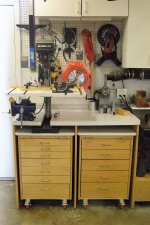Bugsysiegals
Member
- Joined
- Mar 19, 2016
- Messages
- 909
I’m in the beginning planning phases of building base shop cabinets around the exterior walls of my woodshop and have several questions for those of you with more experience. A few clarifications up front, I’ll be using 3/4” plywood, the shop cabinets will be on casters for mobility, standard depth 24”, height 36”, and width about 4’, I may put kitchen laminate countertop on top and do small assembly projects on top or use as in/outfeed tables, and I have the Festool Dominoe and Kreg jig if these matter in terms of any structural integrity of a specific style of build.
That said, I’d like to build the shop cabinets, and all future cabinets, using a 32mm system. I know there are many different 32mm systems out there but am not certain which one is the easiest/most flexible system to use. I prefer frameless cabinets and will likely do a full overlay but may have to build cabinets for others in the future which aren’t frameless. I’d like to be able to continue using the same system for future builds for simplicity and to reduce the chance of mistakes but if it’s preferable to have two different systems I understand.
32mm Systems
I like that the KissII system has diagrams with many different layout options and numbers already calculated so a person doesn’t have to put a whole lot of thought into things but am not sure of the limitations of this system, I think I read it creates gaps if you make any stackable cabinets. If there’s a better system, I could always create a similar manual and laminate it so I can get to work rather than feel like I’m in math class solving problems.
All the cabinet build designs I’ve seen have the cabinet tops/bottoms mounted between the sides. For a shop cabinet, I question whether the tops/bottoms should be between the sides or the sides be between the tops/bottoms. It would seem to me the later would allow for more weight to be supported on top of the cabinet but perhaps not?
Is there anything different I should do like extra pieces of plywood in the corners or a torsion box platform for the bottom since the cabinets will only be supported by 4 casters? I’m not certain how much weight will be within each cabinet, perhaps some paint cans on shelves in at least one cabinet, how strong 3/4” plywood is, and don’t want the cabinets bowing and collapsing.
That said, I’d like to build the shop cabinets, and all future cabinets, using a 32mm system. I know there are many different 32mm systems out there but am not certain which one is the easiest/most flexible system to use. I prefer frameless cabinets and will likely do a full overlay but may have to build cabinets for others in the future which aren’t frameless. I’d like to be able to continue using the same system for future builds for simplicity and to reduce the chance of mistakes but if it’s preferable to have two different systems I understand.
32mm Systems
I like that the KissII system has diagrams with many different layout options and numbers already calculated so a person doesn’t have to put a whole lot of thought into things but am not sure of the limitations of this system, I think I read it creates gaps if you make any stackable cabinets. If there’s a better system, I could always create a similar manual and laminate it so I can get to work rather than feel like I’m in math class solving problems.
All the cabinet build designs I’ve seen have the cabinet tops/bottoms mounted between the sides. For a shop cabinet, I question whether the tops/bottoms should be between the sides or the sides be between the tops/bottoms. It would seem to me the later would allow for more weight to be supported on top of the cabinet but perhaps not?
Is there anything different I should do like extra pieces of plywood in the corners or a torsion box platform for the bottom since the cabinets will only be supported by 4 casters? I’m not certain how much weight will be within each cabinet, perhaps some paint cans on shelves in at least one cabinet, how strong 3/4” plywood is, and don’t want the cabinets bowing and collapsing.

